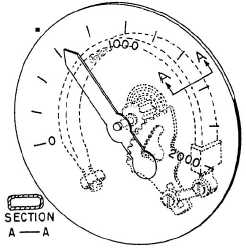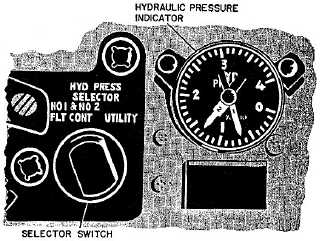To service an accumulator, the hydraulic
pressure that is trapped in the accumulator must be
relieved. This is accomplished by actuating the units
involved. For example, the hydraulic pressure in a
brake accumulator may be relieved by applying the
emergency brake several times. When the hydraulic
pressure is relieved, the accumulator gauge should
indicate the air or nitrogen pressure specified for the
particular accumulator installation. If the pressure
indicated is below the specified pressure, the
accumulator must be recharged with dry compressed
air or nitrogen.
PRESSURE INDICATORS
Pressure gauges installed in hydraulic and
pneumatic systems are used to indicate existing
hydraulic and pneumatic pressures, and are
calibrated in pounds per square inch. Naval aircraft
use both the direct reading gauges and the synchro
(electric) type.
Direct Reading Type
Direct reading gauges are used in installations
such as accumulators, emergency air bottles,
arresting gear snubbers, and brake systems. The
gauge is connected directly into units or lines leading
from units and become part of the container or
system. At these points the gauge is able to sample
existing pressure.
The main part of the direct reading gauge is the
Bourdon tube. The Bourdon tube is a curved metal
tube that is oval in cross-sectional shape (fig. 7-36).
Figure 7-36.—Bourdon tube.
One end of the Bourdon tube is closed, while the
other end has a fitting for connecting it to a pressure
source. The fitting end is fastened to the gauge frame,
while the other end is free to move so it can operate
the mechanical linkage.
Assume that fluid pressure enters the Bourdon
tube. Since fluid pressure will be transmitted equally
in all directions and the area on the outside radius of
the tube is greater than that of its inside, the force
will also be greater on the outside radius, which
tends to straighten the tube. As the movable end of
the tube tries to turn outward, it turns the pivot
segment gear. This gear meshes with a smaller rotary
gear to which a pointer is attached, and its movement
causes a reading on the pressure gauge. The gauge
dial is calibrated so that the needle points to a
number that corresponds to the exact pressure that is
applied. When the pressure is removed, the Bourdon
tube acts as a spring, and returns to its normal
position.
Synchro Type
On most newer aircraft, an electrically operated
(synchro) pressure indicator is used. Figure 7-37
shows the pressure indicator of a typical naval
aircraft. This aircraft is equipped with three
hydraulic systems—No. 1 flight control system, No. 2
flight control system, and utility system. One
indicator provides pressure indication for all three
systems. This type of arrangement is desirable
because it saves instrument panel space.
The indicator system consists of three pressure
transmitters, one located in each of the system lines,
Figure 7-37.—Typical hydraulic pressure
indicator.
7-39





